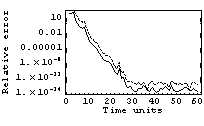|
6.2.2 Reduced-Order State Estimator via Sylvester-Observer Equation
The design of the reduced-order state estimator via the Sylvester-observer equation approach uses the following template.
1. Choose an  stable matrix stable matrix  . .
2. Transform  to the upper observer-Hessenberg form to the upper observer-Hessenberg form  , where , where  is an unreduced block upper Hessenberg matrix and is an unreduced block upper Hessenberg matrix and  (see Section 4.2 for details). (see Section 4.2 for details).
3. Solve the reduced-order Sylvester-observer equation  for a full-rank for a full-rank  matrix matrix  , choosing the , choosing the  matrix matrix  appropriately. appropriately.
4. Find  , an estimate of , an estimate of  , as , as  , where , where  and and  is given by is given by  . .
A single-output recursive bidiagonal scheme due to Datta (1989) to solve the reduced-order Sylvester-observer equation in step 3 is available using the function ReducedOrderEstimator with the option value Method RecursiveBidiagonal. In this scheme, the matrix RecursiveBidiagonal. In this scheme, the matrix  , where , where  , is computed recursively row by row starting with , is computed recursively row by row starting with  and choosing the matrix and choosing the matrix  as an upper bidiagonal matrix with the diagonal entries as poles of the state estimator. The rows of as an upper bidiagonal matrix with the diagonal entries as poles of the state estimator. The rows of  can be computed either sequentially or in parallel. A block version of this scheme is available with the option value Method can be computed either sequentially or in parallel. A block version of this scheme is available with the option value Method RecursiveBlockBidiagonal. For details, see Datta and Sarkissian (2000). RecursiveBlockBidiagonal. For details, see Datta and Sarkissian (2000).
Another scheme, due to Van Dooren (1984), is the multi-output recursive triangular scheme and is available with the option value Method RecursiveTriangular. This scheme computes RecursiveTriangular. This scheme computes  and and  in the form in the form
 , , 
where the diagonal entries  , ... , , ... ,  of the matrix of the matrix  are the user-chosen poles of the estimator. The scheme computes the unknown entries of are the user-chosen poles of the estimator. The scheme computes the unknown entries of  , ,  , and , and  simultaneously row by row, starting from the top row, using certain recursive formulas. A block version of this scheme is also available with the option value Method simultaneously row by row, starting from the top row, using certain recursive formulas. A block version of this scheme is also available with the option value Method RecursiveBlockTriangular. For details, see Van Dooren (1984) or Datta (2003). For other algorithms for solving the reduced-order Sylvester-observer equation, see Bischof, Datta, and Purkayastha (1996), Datta and Saad (1991), and Carvalho and Datta (2001). RecursiveBlockTriangular. For details, see Van Dooren (1984) or Datta (2003). For other algorithms for solving the reduced-order Sylvester-observer equation, see Bischof, Datta, and Purkayastha (1996), Datta and Saad (1991), and Carvalho and Datta (2001).








Design of the reduced-order state estimator via the Sylvester-observer equation.
This constructs the reduced-order state estimator of the steam power system via the Sylvester-observer equation approach using the recursive scheme.
In[18]:=
Out[18]=
This finds the estimates of the state variables.
In[19]:=
This constructs the reduced-order state estimator of the steam power system via the Sylvester-observer equation approach using the block recursive scheme.
In[20]:=
Out[20]=
This obtains the estimates of the states by feeding the input and the measured output to the reduced-order state estimator.
In[21]:=
The graph shows the relative error of the estimated states with respect to the simulated true states for the recursive scheme (solid line) and the block recursive scheme (dashed line).
In[22]:=

|